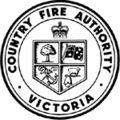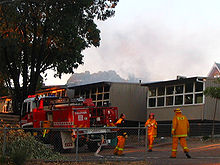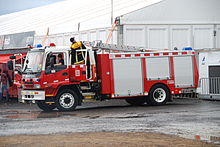- Country Fire Authority
-
Country Fire Authority 
Official Seal and Emblem of the Country Fire AuthorityEstablished: 1945 Regions: 20 Specialities: Combatant Authority for Fire, Rescue and Hazmat Volunteers: ~59,000 Paid Staff: 1,650+ Brigades: 1222 Location: Victoria, Australia Website www.cfa.vic.gov.au Country Fire Authority, or CFA, is the name of the fire service that provides firefighting and other emergency services to all of the country areas and regional townships within the state of Victoria, Australia, as well as large portions of the outer suburban areas and growth corridors of Melbourne not covered by the Metropolitan Fire Brigade. In the event of an emergency in Australia, emergency services including the CFA can be called by dialling 000.
CFA, as it is commonly known, draws the majority of its officers and members from the local community on a volunteer basis. The CFA works closely with the other emergency services within Victoria namely being the State Emergency Service, Victoria Police, Ambulance Victoria and the Metropolitan Fire Brigade working together with unique skill sets and resources for the betterment and safety of all Victorians.
The current Chairman of CFA is Kerry Murphy. Its Chief Executive Officer is Mick Bourke, and its operational Chief Officer of CFA is Euan Ferguson.[2]
The CFA falls under the portfolio of the Minister for Police and Emergency Services, Peter Ryan.
Contents
History
CFA operates under the Country Fire Authority Act of 1958, its amendments and Regulations. This legislation was brought about by significant bushfires during the period 1939-1944 which killed 114 people and destroyed nearly 1400 homes while also damaging large areas of the state and destroying significant amounts of stock. Subsequent investigations showed the lack of a cohesive firefighting agency outside the central metropolitan area and CFA was born on 2 April 1945. Many of its brigades however were established in the 19th century or early in the 20th century.[3]
CFA is one of the world's largest volunteer based firefighting organisations. It services more than 150,000 square kilometres and 3.3 million people, and currently has approximately 59,000 active volunteers with over 550 career firefighters and about 1,100 career support staff.[4]
Funding
The CFA is funded on a 77.5%/22.5% split where Insurance companies provide 77.5% of the funding through fire levies on insurance policies and the Victorian Government provides 22.5% of the funding.[5] In 2006/2007 Insurance companies provided $180.8m and $51.1m was provided from the State Government. The CFA also receives small amounts of funding from the provision of goods and services to external bodies. Additional funding from the government is also provided during serious long duration bushfires.
Individual brigades receive further funds from local councils, from their own fundraising activities and from donations from the community.
CFA Brigades
Fire Brigades
 Logo of the Country Fire Authority
Logo of the Country Fire Authority Main article: List of Country Fire Authority brigades
Main article: List of Country Fire Authority brigadesThere are 1209 brigades (1023 rural, 252 urban and some just brigades), with more than 2300 vehicles across 20 Districts in eight Regions.[6] The Brigades are split up into Regions, Districts then Groups with each division having less brigades in each, however in Urban locations the Region may be the same as the District. There are Eight "Regions", Twenty "Districts" and many Groups. All brigades are in a District and a Region, but may not fall into a group. The CFA's Regions are[7]:
- Barwon Southwest Region -Includes Districts 4, 5, 6 & 7
- Gippsland -Includes Districts 9, 10 & 11
- Loddon Mallee Region -Includes Districts 2, 18 & 20
- Hume Region -Includes Districts 12, 22, 23 & 24
- Grampians Region -Includes Districts 15, 16 & 17
- Northern and Western Metropolitan Region -District 14
- Southern Metropolitan Region -District 8
- Eastern Metropolitan Region -District 13
Coast Guard Brigades
In 2005 the CFA signed a Memorandum of Understanding with the Australian Volunteer Coast Guard to create CFA Coast Guard brigades.[8] All Victorian Coast Guard Vessels will have CFA Radios installed, EAS (Emergency Alerting System) pagers as used by the CFA as well as basic firefighting tools including a small pump and hoses.[9] Additionally all Coast Guard members are to receive basic CFA firefighting training and some land brigades will receive marine firefighting training.
CFA resources
Vehicles
See also: Country Fire Authority appliancesThe CFA owned vehicles consist of nearly 1300 Tankers, 250 Pumpers, 7 Aerial Appliances (telescopic ladders), 30 Rescue Units and various other special purpose and Command and Support vehicles. This fleet is supplemented by more than 1,400 brigade owned vehicles. Brigade owned vehicles are bought and paid for by the individual brigades and communities (sometimes with the assistance of Victorian Government grants) to allow extension of brigade firefighting capability. There are a total of over 4000 vehicles in operation.[10]
Communications
See also: Country Fire Authority DispatchMost CFA firefighters are issued an EAS (Emergency Alerting System) Pager[11] These pagers allow Emergency, Non-Emergency and Administration messages to be sent to members either individually or by groups of people. Brigades are dispatched based on various factors including the time of day, location and type of fire or incident. Although each fire brigade has a primary response zone, other neighboring brigades or specific appliances may be responded as support to the primary brigade. This is especially the case where specialist skills or equipment are needed, such as for road accident rescue or very large structural fires.
When the emergency dispatcher is notified of a fire or incident, he or she sends an Emergency-type message to volunteers or CFA career firefighters via EAS Pager. When this is received by the brigade members, firefighters respond to their station and from there will "turn out" firefighting appliances. While these calls usually come from VicFire (CFA dispatch) as a result of a call to 000, brigades or appliances may also be responded by other dispatch agencies such as D24 (Victoria Police dispatch) or at the request of incident controllers. Other emergency service providers such as Ambulance Victoria and the Victorian State Emergency Service may also request that CFA brigades be responded to an incident.
The CFA has 1,200 base radios, 5,800 mobile radios (mounted on vehicles), 3,000 portable radios (hand held), 35,000 pagers on the EAS network, 58 satellite terminals and 10,700 pre-conference interceptors.[10]
Training
The CFA Operates seven major training facilities at the South Eastern Training Ground (SETG) in Bangholme, Penshurst in Western Victoria, Longerenong (near Horsham), Bendigo, the Gippsland Fire Training Complex in West Sale,[12] Wangaratta and Fiskville near Baccus Marsh.[13] Fiskville is the largest training facility in Victoria and is where Metropolitan Fire Brigade and CFA staff firefighters receive basic training. Fiskville has three precincts including a Hospitality Precinct, a Teaching Centre and Admin Precinct and a PAD Precinct[14] SETG near Carrum is the major Training facility for outer metropolitan brigades, which includes Lecture facilities as well asFlammable liquid spill , Gas Attack and Breathing Apparatus training areas[15]
All members are required to undertake Wildfire "Minimum Skills" training before turning out in a fire truck. This consists of five basic training modules including:[16]
- Personal Protection
- Map Reading
- Wildfire Behaviour
- Wildfire Suppression
- Wildfire Communication
Major incidents
The CFA has been involved in a number of major fires over the years where lives have been lost, including:
- Ash Wednesday fires in 1983
- Linton bushfire in 1998
- The Victorian Alps fires in 2003 and 2007.
- The Black Saturday bushfires in 2009
The CFA has also been involved in combatting interstate fires such as the Sydney fires in 2002 and the 2003 Canberra bushfires.
Activities
The CFA is involved in other non-firefighting operations. The CFA has a leading role in Prevention, Preparedness, Response and Recovery of Fires and other Incidents.[17] The CFA is responsible for all fires on Private land in Victoria outside of the Metropolitan Fire Brigade area including Structure Fires and Bushfires. The CFA has a shared responsibility for Rescues with the Victorian State Emergency Service. In addition to its Response activities members also run prevention programs such as Fire Ready Victoria[18] and Brigades in Schools.
The CFA is also responsible for specialist response functions, including -
- Confined Space Rescue
- Trench Rescue
- High Angle Rescue
- Road Accident Rescue
- Industrial Rescue
- Urban Search and Rescue (USAR)
- Aviation Response
- Marine Response
- Hazardous Materials Response
- Chemical, Biological, Radiological (CBR) Response
United Firefighters Union and the Volunteer Association
The group associated with the CFA is Volunteer Fire Brigades Victoria (VFBV)[19] which was created following the merger of the Victorian Urban Fire Brigades' Association (VUFBA), and the Victorian Rural Fire Brigades' Association (VRFBA). The role of these organisations is to represent the interests of volunteers of urban and rural fire brigades, and deal with the CFA Board, state and federal governments as well as the United Firefighters Union of Australia (UFU). The UFU is the Union that represents the career firefighters in the CFA,[20] however volunteer firefighters are able to join as Associate Members.
The VFBV is also responsible for running the Urban and Rural (respectively) State Championships held each year. These competitions involve brigades from around the state competing in a range of events which are based on current and past fire fighting practices.
Firestar Rose
The official Rose of the CFA is the "firestar" which was introduced in 2010. The rose will be sold by the individual brigades to raise funds and is named after the distinctive shape of the volunteer fire fighter badge.[21]
See also
- Metropolitan Fire Brigade
- New South Wales Rural Fire Service
- South Australian Country Fire Service
- New South Wales Fire Brigades
- Australasian Fire Authorities Council
- List of Country Fire Authority brigades
- CFA Training College, Fiskville
References
- ^ http://www.cfa.vic.gov.au/about/index.htm
- ^ CFA Connect Article - New CFA Chief Offcer (accessed 11 october 2010)
- ^ History - Country Fire Authority website (accessed 10 May 2007)
- ^ About CFA - Country Fire Authority website (accessed 06 Oct 2011)
- ^ CFA Funding Page. Accessed November 21, 2008
- ^ [Editor Sigley, G. (2008). Brigade Magazine, Winter Edition. Country Fire Authority.]
- ^ CFA Our Structure Page. Accessed October 11, 2010
- ^ Conference Proceedings Website. Accessed November 21, 2008
- ^ CFA Annual Report 2008 - Operations Report. Accessed November 21, 2008
- ^ a b CFA Annual Report 2009. Accessed April 10, 2010
- ^ Emergency Services Telecommunications Authority - Projects Page. Accessed November 22, 2008
- ^ Gippsland Information Directory CFA Page. Accessed November 21, 2008
- ^ CFA Training Facilities
- ^ Ballarat Community Tourism directory CFA Page. Accessed November 21, 2008
- ^ Tasmanian Fire Service SETG Page. Accessed November 21, 2008
- ^ Hampton Park CFA Volunteering Webpage. Accessed November 21, 2008
- ^ CFA Annual Report Report of Operations. Accessed November 21, 2008.
- ^ Fire Ready Victoria. Accessed November 21, 2008
- ^ Volunteer Fire Brigades Victoria About Page Accessed Friday November 21, 2008
- ^ United Firefighters Union Eligibility of Membership Accessed Friday November 21, 2008
- ^ http://www.firestar.org.au/why/
External links
- Official Country Fire Authority web site
- CFA Act 1958
- FIREWORLD - CFA Museum and Discovery Centre
- CFA Wiki
Related links
Fire services in Australia Victoria Country Fire Authority · List of CFA Brigades · Country Fire Authority appliances · CFA Training College, Fiskville · Metropolitan Fire Brigade
New South Wales New South Wales Rural Fire Service · List of NSWRFS Brigades · NSWRFS Section 44 · Fire and Rescue NSW
South Australia Queensland Queensland Fire and Rescue ServiceOther states &
national organisationsBushfires in Australia Australian Capital Territory New South Wales South Australia Adelaide Hills bushfires (1939) • Black Sunday bushfires (1955) • Ash Wednesday I (1980) • Ash Wednesday II (1983) • Eyre Peninsula bushfire (2005) • Kangaroo Island Bushfire (2007)Tasmania Victoria Black Thursday (1851) • Red Tuesday (1898) • Black Sunday (1926) • Black Friday (1939) • WW2 bushfires (1943–44) • Ash Wednesday (1983) • Linton bushfire (1998) • Great Divide bushfires (2003) • Grampians region bushfires (2006) • Black Saturday (2009)Western Australia By National Season 1925–26 • 1943–44 • 1954–55 • 1964–65 • 1982–83 • 1996–97 • 2002–03 • 2003–04 • 2005–06 • 2006–07 • 2007–08 • 2008–09 • 2009–10 • 2010–11Categories:- Fire and Rescue services of Australia
- Emergency services in Victoria (Australia)
- Bushfires in Victoria (Australia)
- 1945 establishments in Australia
Wikimedia Foundation. 2010.



